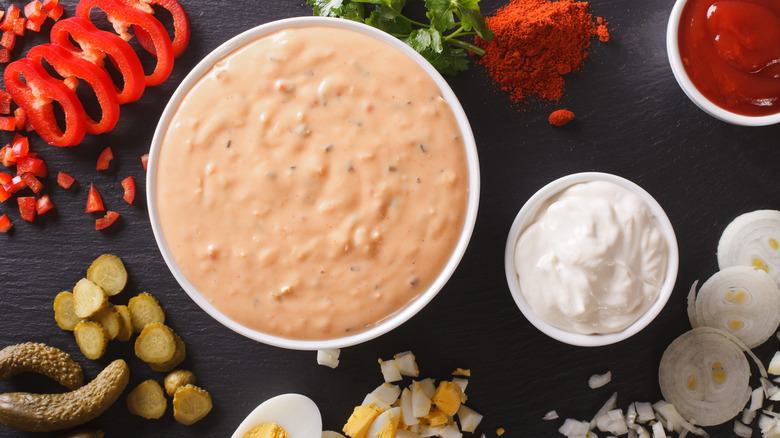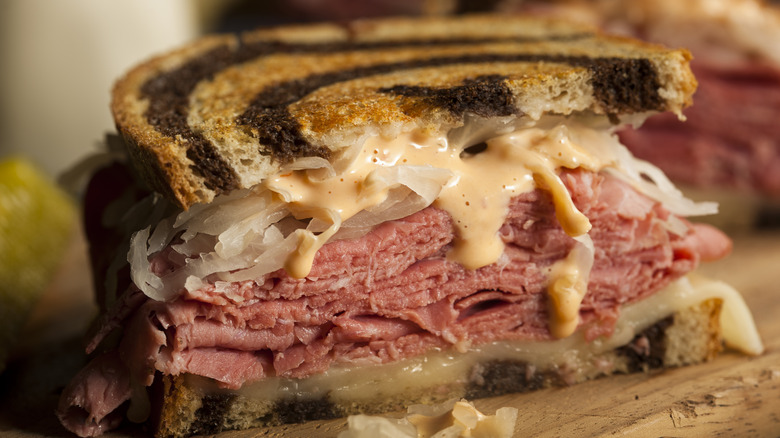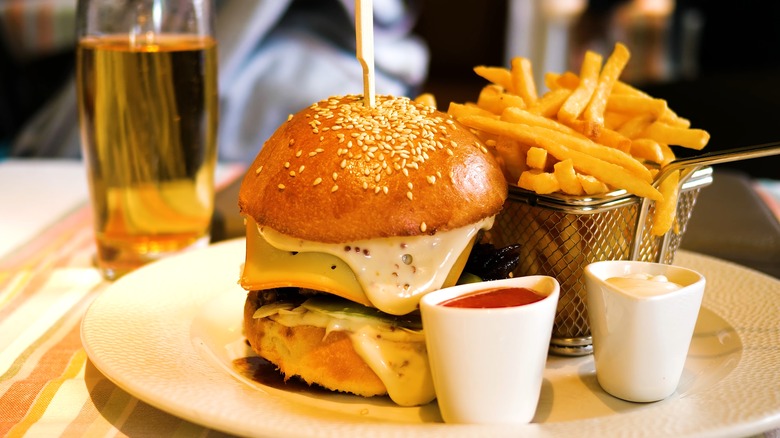The Ingredients That Make Russian Dressing And Thousand Island Different
Russian dressing and Thousand Island are both creamy, pink-hued, delicious sauces that many sandwiches or salads would be incomplete without. While there are a lot of overlapping ingredients, there are also some key differences between these two iconic slathers.
To start, both are mostly made from a mix of mayonnaise and ketchup, but generally, Russian dressing is a little spicy while Thousand Island tends to be on the sweeter side. Each may include chili sauce in addition to, or sometimes instead of, ketchup. The chili sauce doesn't provide that much of a variation, though, when mixed with the other elements.
The key ingredient that sets Russian dressing apart, however, is horseradish. On its own, horseradish can be downright nostril-clearing, but when mellowed by the fat content and sweetness of Russian dressing, it lends a brighter edge. On the other hand, Thousand Island dressing gets an extra sugary pop from sweet pickle relish, and often includes finely chopped hard-boiled egg in the mix.
The history of these two sauces
It's believed that Russian dressing was likely created back in the early 1900s by a New Hampshire resident named James E. Colburn. At the time, the sauce got its signature pink color from ground-up poached coral and lobster shells, and actually featured one more surprising delicacy of the sea — caviar, the real deal sturgeon stuff. The Russian association with caviar is more than likely what lent this dressing its name, too.
Thousand Island dressing was also created just a stone's throw away and around the same time period. It is thought that this salad dressing was developed at the popular summer resorts located between upstate New York and southern Ontario, Canada, an area on either side of the St. Lawrence River referred to as the Thousand Islands region.
These days, Russian dressing has a firm placement on the classic, toasty, melty, Reuben sandwich — a Jewish deli mainstay that stacks sliced corned beef, Swiss cheese, tangy sauerkraut, and a generous amount of Russian dressing between slices of toasted rye bread. On the other hand, Thousand Island dressing is most iconically served on a '60s and '70s salad bar-style mix made up of iceberg lettuce, half-moon cut cucumbers, cherry tomatoes, shredded carrots, and the like.
The gray area of Russian dressing and Thousand Island
The ingredients used to make Russian dressing and Thousand Island can overlap quite a bit, as mentioned. As well, both can be seasoned with Worcestershire sauce, lemon juice, and paprika. Onion powder and mustard powder are more commonly found in Russian dressing while you are more likely to find a squeeze of mustard or finely-chopped onion in Thousand Island dressing, but that's not a hard and fast rule.
Thousand Island may be more likely to contain chives, parsley, chopped olives or bell pepper, in addition to the boiled egg, but some versions don't contain egg at all. Thousand Island is typically the milder of the two dressings, but it can also have a dash of hot sauce. Russian dressing can also sometimes include diced pickles just like its counterpart.
In fact, the names of these two sauces are sometimes used interchangeably. Other condiments like a special sauce and comeback sauce are basically riffs on Russian dressing and Thousand Island, as well. A version of this delightful, sweet, creamy, and tangy sauce you may be familiar with from an annual family reunion, classic greasy spoon diner, or smash burger joint likely falls somewhere in the middle.



